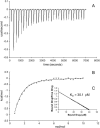Investigation of ligand binding to the multidrug resistance protein EmrE by isothermal titration calorimetry
- PMID: 15501941
- PMCID: PMC1305024
- DOI: 10.1529/biophysj.104.049247
Investigation of ligand binding to the multidrug resistance protein EmrE by isothermal titration calorimetry
Abstract
Escherichia coli multidrug resistance protein E (EmrE) is an integral membrane protein spanning the inner membrane of Escherichia coli that is responsible for this organism's resistance to a variety of lipophilic cations such as quaternary ammonium compounds (QACs) and interchelating dyes. EmrE is a 12-kDa protein of four transmembrane helices considered to be functional as a multimer. It is an efflux transporter that can bind and transport cytoplasmic QACs into the periplasm using the energy of the proton gradient across the inner membrane. Isothermal titration calorimetry provides information about the stoichiometry and thermodynamic properties of protein-ligand interactions, and can be used to monitor the binding of QACs to EmrE in different membrane mimetic environments. In this study the ligand binding to EmrE solubilized in dodecyl maltoside, sodium dodecyl sulfate and reconstituted into small unilamellar vesicles is examined by isothermal titration calorimetry. The binding stoichiometry of EmrE to drug was found to be 1:1, demonstrating that oligomerization of EmrE is not necessary for binding to drug. The binding of EmrE to drug was observed with the dissociation constant (K(D)) in the micromolar range for each of the drugs in any of the membrane mimetic environments. Thermodynamic properties demonstrated this interaction to be enthalpy-driven with similar enthalpies of 8-12 kcal/mol for each of the drugs in any of the membrane mimetics.
Figures





Similar articles
-
SMR proteins SugE and EmrE bind ligand with similar affinity and stoichiometry.Biochem Biophys Res Commun. 2005 Sep 16;335(1):105-11. doi: 10.1016/j.bbrc.2005.07.051. Biochem Biophys Res Commun. 2005. PMID: 16055085
-
Examination of EmrE conformational differences in various membrane mimetic environments.Biochem Cell Biol. 2003 Apr;81(2):61-70. doi: 10.1139/o03-031. Biochem Cell Biol. 2003. PMID: 12870870
-
Spectroscopic analysis of small multidrug resistance protein EmrE in the presence of various quaternary cation compounds.Biochim Biophys Acta. 2012 May;1818(5):1318-31. doi: 10.1016/j.bbamem.2012.01.022. Epub 2012 Feb 2. Biochim Biophys Acta. 2012. PMID: 22326892
-
Precious things come in little packages.J Mol Microbiol Biotechnol. 2001 Apr;3(2):155-62. J Mol Microbiol Biotechnol. 2001. PMID: 11321568 Review.
-
A common binding site for substrates and protons in EmrE, an ion-coupled multidrug transporter.FEBS Lett. 2000 Jun 30;476(1-2):93-7. doi: 10.1016/s0014-5793(00)01677-x. FEBS Lett. 2000. PMID: 10878258 Review.
Cited by
-
X-ray structure of EmrE supports dual topology model.Proc Natl Acad Sci U S A. 2007 Nov 27;104(48):18999-9004. doi: 10.1073/pnas.0709387104. Epub 2007 Nov 16. Proc Natl Acad Sci U S A. 2007. PMID: 18024586 Free PMC article.
-
Assembly and regulation of the chlorhexidine-specific efflux pump AceI.Proc Natl Acad Sci U S A. 2020 Jul 21;117(29):17011-17018. doi: 10.1073/pnas.2003271117. Epub 2020 Jul 7. Proc Natl Acad Sci U S A. 2020. PMID: 32636271 Free PMC article.
-
Impact of hapten presentation on antibody binding at lipid membrane interfaces.Biophys J. 2008 Apr 15;94(8):3094-103. doi: 10.1529/biophysj.107.115519. Epub 2008 Jan 16. Biophys J. 2008. PMID: 18199665 Free PMC article.
-
Structural and functional comparison of hexahistidine tagged and untagged forms of small multidrug resistance protein, EmrE.Biochem Biophys Rep. 2015 Mar 26;1:22-32. doi: 10.1016/j.bbrep.2015.03.007. eCollection 2015 May. Biochem Biophys Rep. 2015. PMID: 29124131 Free PMC article.
-
Isothermal titration calorimetry of membrane proteins - progress and challenges.Biochim Biophys Acta. 2014 Jan;1838(1 Pt A):69-77. doi: 10.1016/j.bbamem.2013.05.023. Epub 2013 Jun 5. Biochim Biophys Acta. 2014. PMID: 23747362 Free PMC article.
References
-
- Arkin, I. T., W. P. Russ, M. Lebendiker, and S. Schuldiner. 1996. Determining the secondary structure and orientation of EmrE, a multi-drug transporter, indicates a transmembrane four-helix bundle. Biochemistry. 35:7233–7238. - PubMed
-
- Bolhuis, H., H. W. van Veen, J. R. Brands, M. Putman, B. Poolman, A. J. M. Driessen, and W. N. Konings. 1996. Energetics and mechanism of drug transport mediated by the lactococcal multidrug transporter LmrP. J. Biol. Chem. 271:24123–24128. - PubMed
-
- Butler, P., I. Ubarretxena-Belandia, T. Warne, and C. Tate. 2004. The Escherichia coli multidrug transporter EmrE is a dimer in the detergent-solubilised state. J. Mol. Biol. 340:797–808. - PubMed
-
- Dougherty, D. A. 1996. Cation-π interactions in chemistry and biology: a new view of benzene, Phe, Tyr, and Trp. Science. 271:163–168. - PubMed
Publication types
MeSH terms
Substances
LinkOut - more resources
Full Text Sources
Molecular Biology Databases

